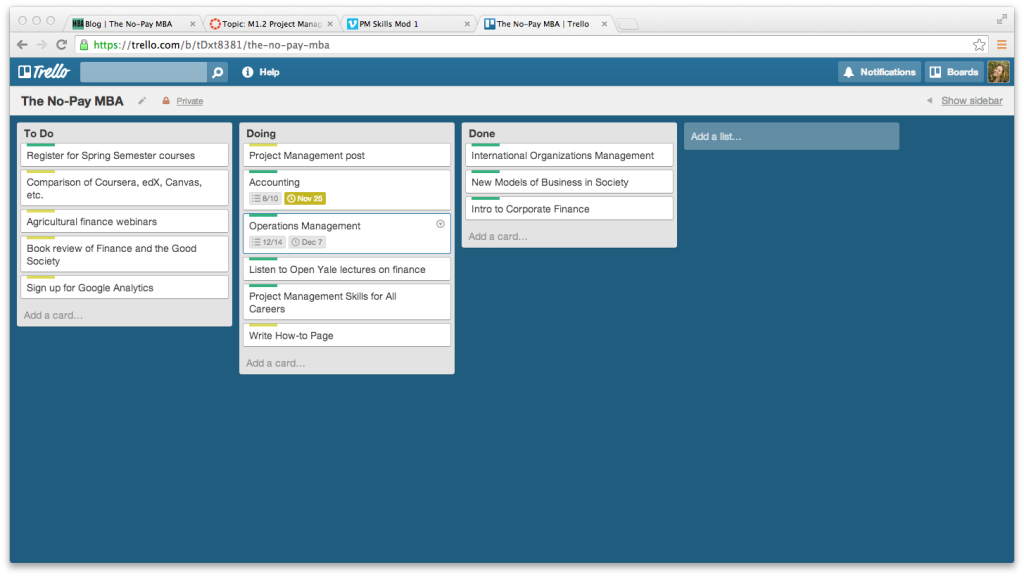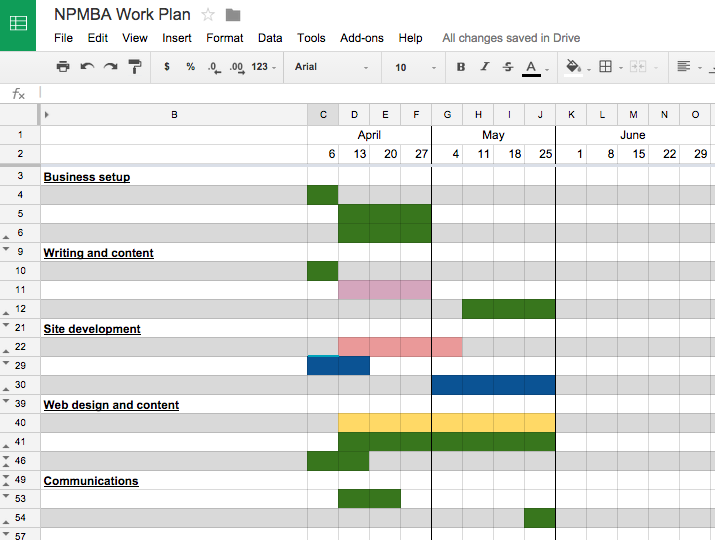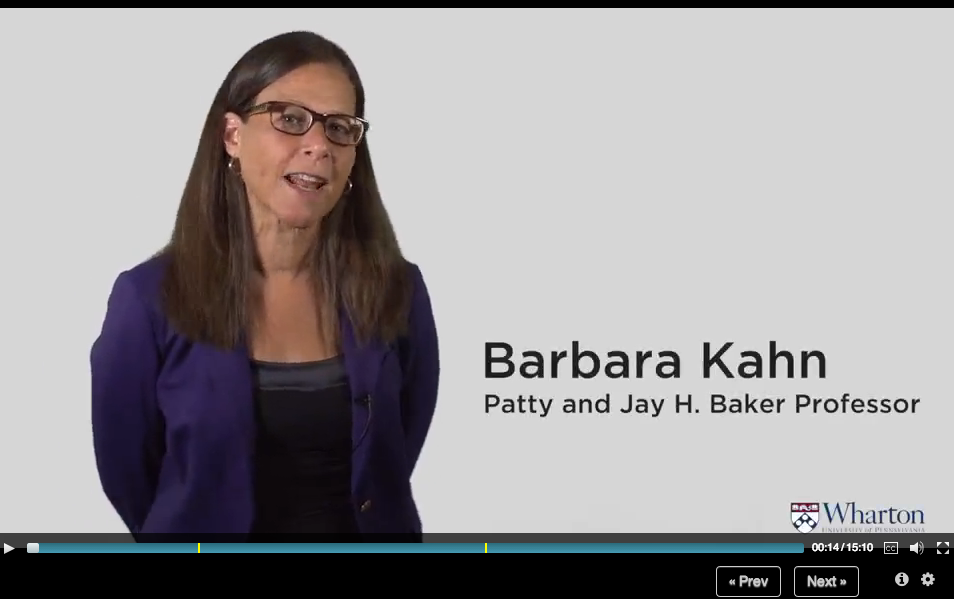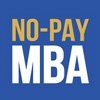by Laurie Pickard | Jul 13, 2015 | Community and Networking, Most popular posts

How much of the $150,000 - $200,000 that MBA students in top programs spend on business school is for the value of having a great network?
A third? Half?
While we may not be able to pinpoint a dollar-value for the business school network, we can probably agree that it is a significant part of the value of attending an MBA program.
That’s why when I started my project to get the equivalent of an MBA using free massive open online courses (MOOCs), I knew that I would need to be deliberate about building a great network to match the top-tier education that had suddenly become available for free.
Here’s how I did it - and how you can build a network to rival any business school grad’s.
Choose what you want to be known for
You don’t have to be the first, the only, or even the best at what you’re passionate about in order to engage in the conversation; I’m certainly not the first person to suggest that it’s possible to get a business education outside of a university. I’m not even the first person to think of getting an MBA equivalent using MOOCs.You do, however, have to put yourself out into the world, even if you don’t feel totally ready. When I began blogging about using MOOCs to get a business education, I didn’t yet have any credibility in the business world. Over time, I’ve managed to turn my website into an excellent lead-generator for connecting with fellow students, advisors, and potential employers. Now it’s just as likely that I’ll be contacted by a fellow ed tech entrepreneur as the other way around. But it didn’t start out that way.
To start growing your network, begin by identifying what you want to be known for. Then work on bringing your public persona in line with your aspirations. This sounds daunting, but it doesn’t have to be.
Comment on blog posts, share articles on social media, tweet about what’s happening in your field, guest post on a blog. Create your own blog or website, or just rock your social media profiles. If you don’t feel totally confident at first, that’s okay. Confidence comes later. Just get started.
Approach networking as relationship building, not trophy hunting
I’ve gotten some amazing publicity, and I’ve been fortunate to get to talk to some of the luminaries of education, people like edX CEO Anant Agarwal. But networking is not trophy hunting.
What has made my network great is engaging with people again and again, finding out where my contacts’ goals align with mine, and being genuine and helpful. That approach has paid off a thousand fold.
A write-up is nice, but the chance to build a new relationship with someone who shares my passion for tech-enabled business education is better.
Your network should include a mix of peers, mentors, and people who can connect you to opportunities. The thing is, you don’t always know which are which. Don’t neglect building relationships with your peers just because they might not be able to help you today. Opportunities can arise from many places. By the same token, don’t be afraid to circle back to big shots you’ve been fortunate enough to make contact with.
Be a human online
The internet can feel impersonal, but I’ve learned that you can change your experience of the internet by treating all interactions as human ones. It’s incredible how far you can get with people when you approach them as human beings, even if you’re writing through a contact form.
My network includes many people I have never met face to face who are nonetheless trusted advisors, collaborators, and friends.
For starters, your LinkedIn profile should include a personal description that doesn’t make you sound like a resume-writing robot.
Next, when someone’s work inspires you, don’t be afraid to reach out to let them know. This goes especially for people who are building something from scratch. My experience is that these are the people who are most receptive to engaging with those who care about the work they’re doing. I’ve managed to make personal connections with many entrepreneurs, writers, and professors whose work I admire, simply by reaching out online in a way that is respectful, appreciative, and human.
Don’t be afraid to be one of the first people dancing
Derek Sivers gives a great TED Talk in which he breaks down how social movements start, using a fantastic video that begins with one guy dancing at a concert. The first person to start dancing seems crazy, the next few to join in risk looking foolish alongside him, but then suddenly everyone joins in. New projects have a similar trajectory.
Being one of the first people dancing - while you’re still visible and exposed - can be scary, but it can also lead to great rewards. No one is building a future on dancing at a concert, so the metaphor breaks down there, but many of the most exciting new companies are built on communities and social movements. Being one of the early joiners can pay off in a big way.
In my case, I am that person dancing alone in a field. Or at least I was. Some people have started dancing with me, but we’re still a small enough group to be able to know one another personally. If you find a movement you can get excited about, don’t be afraid to join in at an early stage.
If you’re inspired by No-Pay MBA’s project of re-imaging business education, taking the content and the people and the resources that are out there and putting them back together as a new breed of business education, then I invite you to join in.
In the spirit of this entire project, I am excited to share my network with you and to build it further with your help. I am looking for those peers, mentors, and providers of opportunity who share my enthusiasm and a desire shape the future of business education.
Will you be one of them?
by Laurie Pickard | Apr 18, 2015 | Career Development, Community and Networking, Most popular posts

I am what you might call a solopreneur, which Urban Dictionary defines as “an entrepreneur who works alone, ‘solo,’ running their business single-handedly. They might have contractors for hire, yet have full responsibility for the running of their business.” This describes No-Pay MBA to a tee. While I am in some ways a one-woman show, I have managed to assemble a team of consultants who are helping me get to launch day of what I’m calling No-Pay MBA 2.0.
One of the most exciting things about the No-Pay MBA project is its global nature. Almost every country in the world is represented among my readers. Likewise, those who have pre-registered for No-Pay MBAs come from every place imaginable - from Durban to Dallas, Mexico City to Mumbai.
My team is similarly global. Andrea is an American living in Rome, and she’s helping with social media and communications. Adam, a British guy living in Mexico, is on web development. If you take a look at some of his work, I think you’ll see why I’m so excited about what he’s doing to help me build the profile section of the new and improved No-Pay MBA website. Greg in Australia is helping with front-end layout and design; and Kevin Meldau, who is South African and living in Florida, is working on graphic design. He’s just created a new logo that I’m really excited about, and you can see other samples of his work here.
If you count both our places of birth and the countries in which we currently reside, this team of five represents seven countries. Only two of us are in the same time zone.
I’m studying management in my MOOC coursework, but working with this team to launch this business has also been a great experience in project management. I tend to enjoy the challenge of pulling together a great product on a tight deadline. Working with a geographically dispersed team has added a level of complexity to this endeavor that has forced me to up my game.
Below are some of the tools I’ve found helpful and some tips for managing a working relationship even when you’re miles apart.
Tools and tips for managing a global team
You are probably very familiar with the big dogs of remote teamwork - Google Drive and Dropbox for sharing documents, Skype and Hangout for communication.
But here are a few other free tools you may not be aware of.
Tools for working across time zones
World Time Buddy
World Time Buddy is a handy reference for scheduling when you’re in separate time zones. The free version allows you to compare three time zones.

Time Trade
I’ve just started using TimeTrade to schedule appointments. This helpful service allows me to specify when I’d like to schedule which type of appointments and allows clients to book time on my calendar themselves.
Google Calendar
And of course there’s that old standby Google Calendar. What you might not know about Google Calendar is that it automatically translates calendar invites into the recipient’s time zone.
Tools for managing work
Trello
Trello is a simple but powerful application for visual project management. It uses a system called Kanban, in which the project is mapped out using cards. The cards can be moved and rearranged to indicate level of priority and the stage each task is in. Adam and I are using Trello to collaborate on web development.

Gantt Charts
I’m a big fan of Gantt charts for mapping out and visualizing the project timeline. I like to create my own Gantt charts in Google Sheets and then add my team members as collaborators, but there are plenty of free web-based tools that can be used for the same purpose. The chart below shows how I’ve color coded various elements to indicate which person is taking the lead. This article has some great suggestions.

Tools for finding talent
ODesk
I used ODesk for the first time while assembling this team. If you haven’t heard of it, ODesk is one of several sites that act as a marketplace for freelancers to sell their services. These sites are all part of an emergent re-ordering of the workforce, which I find totally fascinating. If you’d like to better understand this new flexible work economy, The Economist had a great piece on the future of work a few months back.
Coursolve
Yes, I am a solopreneur, but I don’t plan to stay solo forever. I’m using Coursolve, a digital internship platform, for my long game. I recently posted a No-Pay MBA project to the site, which I hope will help me further hone my management skills and build my network of talent. If you’re interested, you can join my project here.
Tips on managing a global team
Peter Drucker, who is sometimes called “the father of modern management” is reputed to have said that “organizational culture eats strategy for breakfast.” While the true origin of this quote is up for some debate, its wisdom is generally accepted. Human relationships are the most important part of any business. Creating strong relationships can be more difficult when your team members are not physically in the same place, but it’s still just as important.
Use video, even when it’s awkward.
Don’t underestimate the importance of seeing the face of the person you’re working with. I do a lot of work via email, but a call every once in a while goes a long way towards establishing the kind of human connection that fosters a good working relationship. Even when my connection speed is giving me grief, I still like to at least start face to face in any online call. Whether or not I turn my camera off, this little bit of face time helps to establish a connection.
Make sure consultants see their part in the whole.
It’s important for anyone working on your project to understand where they fit into the big picture, how you plan to use their work, and why it is critical to the success of the project.
Be clear about expectations.
Especially when working with consultants who are not full-time employees, it’s important to make sure that both parties are in agreement about what work is to be done, what constitutes a successful outcome, and of course, compensation.
Tell your people you appreciate their work.
This is so important. Everyone needs to be recognized when they’ve done good work.
In that spirit, I’d like to close this post with a few shout-outs:
Andrea, thank you for being so organized and on top of things. You’ve cut my stress level tremendously and given me what feels like extra hours in the day to get things done.
Adam, thank you for your collaborative work style. I love that I am working with you on my site and that you’ve taken the time to understand my vision for it.
Greg, thank you for all your tips and pointers on SEO and for your great suggestions on design. I can’t wait to see what you come up with!
Kevin, I love your vision and your enthusiasm. Thank you for stepping up to fill a critical need at just the right time.
by Laurie Pickard | Feb 9, 2015 | Career Development, Community and Networking, MOOC MBA Design, Most popular posts
I’m pleased to share a guest post by Nick Switzer, who offers a tremendous example of how a MOOC MBA can be even more valuable than a traditional MBA. For those considering a No-Pay MBA, I expect you’ll find his story as inspiring and intriguing as I did. Enjoy! -Laurie
Why I turned down a company-paid MBA for a No-Pay MBA
 Everyone pursuing a No-Pay MBA is doing so because they cannot afford a traditional paid, brick and mortar MBA, right? A No-Pay MBA is the only option; otherwise, we would all enroll in traditional MBAs, right?
Everyone pursuing a No-Pay MBA is doing so because they cannot afford a traditional paid, brick and mortar MBA, right? A No-Pay MBA is the only option; otherwise, we would all enroll in traditional MBAs, right?
Not necessarily.
I work for a fantastic company with great benefits. One of those benefits is tuition reimbursement. If I take university courses that pertain to my role at the company, then the company pays for my tuition. As an engineer transitioning to a more business-oriented engineering role, I needed some financial and business training. My managing director (let’s call him Steve) knew this, and during a one-on-one lunch he suggested that I pursue a traditional MBA, taking advantage of the company’s tuition reimbursement policy.
I was flattered. Steve was my manager’s manager, a role model in the company, and he was telling me that the company would fund my MBA! However, after some deliberation, I declined this offer in favor of a No-Pay MBA using Coursera and other MOOC providers.
Why did I do this? How could I turn down such a generous benefit from my company?
I’ll give you 5 big reasons.
1. I value my time with my family.
When I started my No-Pay MBA, my wife and I were expecting our first child. My wife was a successful marketing manager for a Fortune 500 company at the time, with no plans to leave her role after maternity leave. I was committed to supporting her career, our family development, and my own career. I did not think it was possible to both perform well at my job and be a supportive father and husband, all while attending MBA classes and studying.
With a No-Pay MBA, I watched half of each weeks’ lectures in the same amount of time I would have spent in traffic commuting to off-site classes. Often I would do my courses while my child was sleeping, either early in the morning or late at night.
In this way, MOOCs allowed me to maximize time with my family.
2. I needed to learn quickly and apply my skills immediately.
In my new role, I needed business strategy and finance understanding immediately! Time lost taking the GMAT, GRE, selecting a program and applying meant real business opportunities lost. Through MOOCs, I was able to access top educational content within minutes of choosing my courses!
By the time director Steve suggested I start a paid MBA, I had already started 2 courses that were paying dividends in the office.
I immediately applied principles learned in class in the workplace with many co-workers who had graduated with paid MBAs, honing my learning in real-life scenarios.
Unlike a traditional MBA, I have the ability to share course materials directly with my co-workers as well. This has resulted in empowering my project teams to learn principles on the fly, when they need them most.
3. I wanted to choose my courses based on what would be most helpful at work.
One of the things I love most about MOOCs is the ability to craft my own curriculum.
I have a passion for data-driven decisions, so I am taking a 10-course Data Science specialization from Johns Hopkins as a focal point in my No-Pay MBA.
This type of curriculum flexibility and the ability to take courses from multiple top universities is simply unbeatable.
This was also helpful to my company because I was able to take the courses I needed immediately. I needed financial analysis and negotiation strategy, and I was able to take those courses right away.
4. I saved my company a lot of money.
In the recession of 2008, many companies suspended their tuition reimbursment programs for at least 6 months. I did not want to see my further education as a financial burden to my company.
As a responsible employee of my company, I made a serious cost-saving decision in pursuing a No-Pay MBA. This was an easy point for my director to understand.
My company is still investing in me, more in time commitment than in cash. This investment has paid off quickly, as my No-Pay MBA has armed me with frameworks that allow me to attack problems quickly.
5. I want MOOCs to succeed!
I believe broad, low-cost access to excellent educational materials will help our world, enriching lives and offering new paths to personal achievement and more stable economic conditions.
I want my daughters to live in a world where they have access to top-notch education without going into significant debt.
I want to see MOOCs succeed. What better way to help this happen than as a living example of the power of low-cost online education?
The Results
 Since I started my No-Pay MBA, my wife and I have been fortunate enough to have two great little daughters. My wife has been promoted, and because our schedules aren’t in conflict, she has been able to go on several international work-trips while I take care of the kids after work.
Since I started my No-Pay MBA, my wife and I have been fortunate enough to have two great little daughters. My wife has been promoted, and because our schedules aren’t in conflict, she has been able to go on several international work-trips while I take care of the kids after work.
On the job, I use frameworks and concepts from my courses every day. Thanks to my No-Pay MBA, I am totally comfortable having high-level financial and business strategy discussions with graduates from traditional MBA programs. I have also earned a promotion since starting this adventure in non-traditional education.
Bottom line: a No-Pay MBA aligned better with my goals of work-life balance and prioritization of my family than a standard MBA would have. It has been fantastic for my family, for my company and for me.
Nick Switzer is an engineer, a German-English technical translator, and a lifelong learner. To see his complete MOOC MBA transcript, visit www.nickswitzer.us.
by Laurie Pickard | May 2, 2014 | Most popular posts, Thoughts on Higher Ed and Life

Ladies, the numbers don’t look good. Though there isn’t much data specific to business courses, those studies that have been done on MOOC enrollment rates point to an overall trend of many more men than women taking advantage of free online courses. The numbers vary, but the story is largely similar. In one study of MOOC users, female students were 41% of the population; in another, they were only 36%. EdX recently released a profile of its users, only 29% of whom are women. As one article summarized the research, “students tend to be young, well-educated males who are trying to advance in their jobs.”
I started thinking about this topic when I clicked on the first video lecture for Wharton’s Introduction to Marketing and found myself surprised to see a female professor. I’m not sure why it didn’t occur to me before that moment, but I realized that almost all of my MOOC professors have been men. I did one short course on human resources taught by a woman, and there were a couple of brief units taught by women in my course on international organizations management, but the vast majority of my courses so far have been taught by men. This got me thinking about women’s participation in MOOCs, both as students and as professors.
Though I didn’t find any formal research, preliminary evidence suggests that the stats among MOOC professors are even worse than those among MOOC students. Out of curiosity, I conducted my own informal survey of Coursera’s Business and Management course offerings. The 62 courses I found included the following:
| Business courses taught by one man |
42
|
| Business courses taught by two or more men |
11
|
| Business courses taught by mixed gender groups |
8
|
| Business courses taught by one woman |
1
|
| Business courses taught by a group of women |
0
|
So there you have it. Women are under-represented in business MOOCs, just as they are in business school generally.
Now that I’ve shared these disheartening statistics, let me tell you why I’m optimistic about the potential of business MOOCs to be a great boon to women.
1. MOOCs are so new that these numbers could easily change. The overall trend may be that more MOOC students are men, but at least in my Accounting course last year, the gender gap was markedly less than in the studies I mentioned previously.
2. The economic arguments that keep some women out of MBA programs do not apply to MOOCs. Some women who choose not to go to traditional business school may be making the right financial choice, especially if they want to prioritize family, have flexibility in their careers, or take any extended breaks from working. Women who want to learn business skills without going deeply into debt – especially if they don’t plan to put their careers before other priorities – may find that a MOOC-based education makes more sense for them than a traditional degree program.
3. For women who do intend to apply to B-school, taking a few MOOCs can be a great way to build confidence prior to enrolling.
4. The number of women-owned businesses grew by 41% between 1997 and 2013. A regular MBA might not be the greatest investment for a woman who wants to start her own businesses. Conversely, free online education can provide what an entrepreneur needs to get started without the debt to weigh her down.
Have I convinced you? If so, why not enroll in a MOOC today? We need to get our numbers up!
by Laurie Pickard | Nov 15, 2013 | MOOC MBA Design, Most popular posts
“A dollar today is worth more than a dollar tomorrow.” Most of us have probably heard someone say something to this effect. We understand intuitively that a dollar in hand is preferable to a dollar some future date. But why is this true?
Turns out it is possible to calculate exactly how much more a dollar today is worth than a dollar tomorrow, five years from now, or twenty years from now. The discount rate, otherwise known as the rate of inflation, can be used to take today’s dollar and translate it into future dollars – or to figure out how much a future amount of cash would be worth today.
This type of analysis is a powerful tool for determining whether a given investment is a good idea or not. To do this, you simply compare the amount of the investment to the predicted future cash flows from the investment, discounted back over the life of the project. Simple. This analysis is known as the net present value (NPV) of the investment - in other words, how much the whole investment is worth in today’s dollars.
What is the value of The No-Pay MBA? Or of any MBA for that matter? Answering this question is fairly simple – it just requires making a few assumptions.
First, let’s assume that the No-Pay MBA is not in fact completely free. Let’s say I end up spending around $1000 up front. This covers what I’m paying for internet access, web hosting, wear and tear on my computer, business books I’m buying, and other expenses.
Second, I’m assuming that there is no opportunity cost of The No-Pay MBA. It’s not taking time away from other employment, it’s not keeping me from doing any kind of paying work, and there is nothing else I could be doing with the time I spend working on my MBA that would result in monetary compensation.
Third, I’m assuming that I’ll be able to leverage this project to get a higher salary in the future. Let’s say as a result of having done the No-Pay MBA I’m able to earn $5,000 additional income per year starting a year after I finish.
Finally, I’m assuming a 3% interest rate.
The calculation can be done in Excel, and it looks something like this:
| Year |
Additional income or expense |
NPV |
|
0
|
$(1,000.00)
|
$(1,000.00)
|
|
1
|
$-
|
$-
|
|
2
|
$-
|
$-
|
|
3
|
$5,000.00
|
$4,575.71
|
|
4
|
$5,000.00
|
$4,442.44
|
|
5
|
$5,000.00
|
$4,313.04
|
|
6
|
$5,000.00
|
$4,187.42
|
|
7
|
$5,000.00
|
$4,065.46
|
|
8
|
$5,000.00
|
$3,947.05
|
|
9
|
$5,000.00
|
$3,832.08
|
|
10
|
$5,000.00
|
$3,720.47
|
|
11
|
$5,000.00
|
$3,612.11
|
|
12
|
$5,000.00
|
$3,506.90
|
|
13
|
$5,000.00
|
$3,404.76
|
|
14
|
$5,000.00
|
$3,305.59
|
|
15
|
$5,000.00
|
$3,209.31
|
|
16
|
$5,000.00
|
$3,115.83
|
|
17
|
$5,000.00
|
$3,025.08
|
|
18
|
$5,000.00
|
$2,936.97
|
|
19
|
$5,000.00
|
$2,851.43
|
|
20
|
$5,000.00
|
$2,768.38
|
|
21
|
$5,000.00
|
$2,687.75
|
|
22
|
$5,000.00
|
$2,609.46
|
|
NPV of No-Pay MBA |
$69,117.23
|
After adding up the present value of each years’ worth of additional salary, it turns out that after 22 years, the No-Pay MBA is worth $69,117.23!!!! Wow!
But let’s say I can’t get $5,000 additional salary each year. Let’s say I can only get $2,000 additional salary. In that case, the No-Pay MBA is only worth $25,216.61. That’s still a lot given how little it’s costing me.
Or what if I can only get a one-time salary bump of $3,000 some time in the middle or my career – let’s say after 7 years. In that case, the No-Pay MBA is only worth $1,439.
Going through these calculations for different assumptions is called sensitivity analysis. I’ve played around with my assumptions, but no matter how you slice it, the No-Pay MBA is a good value. In corporate finance, any investment with an NPV that is a positive number is considered a good investment.
By contrast, a regular business degree comes with a much higher price tag, as well as a much greater opportunity cost. I’ve also estimated how much money I would have to earn each year in order to justify the expense of a traditional MBA. Assuming a total cost of $250,000 (including the opportunity cost of lost years of salary), I would have to earn $15,500 in additional income every year just to break even. I don’t mean to bad mouth traditional MBA programs – and it isn’t actually very far fetched that someone with that degree could earn an additional $15,000 per year, or even a lot more than that. But given my industry and the fact that I’m the trailing spouse of a foreign service officer, the free option seems like a much safer bet.












